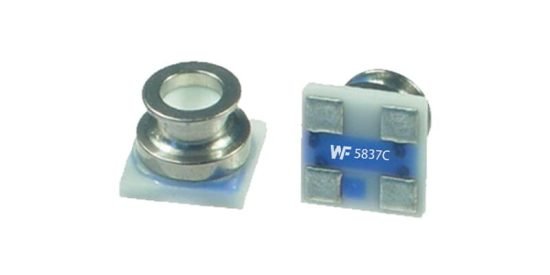목록
기압계를 사용하여 10cm 이내의 높이 해상도를 달성할 수 있는 기압계는 무엇입니까?
일반 기압계(압저항형, 용량형 또는 MEMS 실리콘 공진형)에만 의존하면 임의의 환경에서 10cm 높이 분해능을 안정적이고 안정적으로 구현하는 것이 거의 불가능합니다.
왜 이렇게 힘든지
1. 물리적 한계: 압력-높이 관계
표준 해수면 대기압은 약 101,325Pa입니다. 표준 해수면 조건에서 높이가 10cm 증가하면 대기압은 약 0.012Pa 감소합니다. 이는 믿을 수 없을 만큼 작은 변화입니다. 이에 비해, 성인이 방 안을 아무 생각 없이 돌아다닐 때 발생하는 공기 교란은 쉽게 몇 파스칼의 압력 변화를 일으킬 수 있습니다. 문과 창문을 열거나 닫는 것, 에어컨 장치를 켜거나 끄는 것, 심지어 가벼운 바람조차도 0.012 Pa보다 훨씬 더 큰 압력 변동을 일으킬 수 있습니다.
2. 센서 자체의 한계
소음 및 해상도: 많은 고성능 MEMS 기압계(예: WF280A, WF5837C)가 매우 미세한 디지털 분해능(예: 0.01 Pa)을 제공하지만 이것이 정확도나 안정성이 실제로 해당 수준을 충족한다는 의미는 아닙니다. 내부 센서 소음, 온도 드리프트 및 장기 안정성은 모두 오류를 유발하며 이러한 오류는 일반적으로 10cm 높이 변화에 해당하는 압력 차이보다 훨씬 큽니다.
절대 정확도와 상대 정확도: 기압계는 일반적으로 높이 약 ±0.5m에 해당하는 절대 정확도(예: ±50Pa)로 평가됩니다. 이 사용 사례에서 더 중요한 것은 상대 정확도 또는 단기 안정성입니다. 즉, 짧은 간격에 걸쳐 높이 변화를 얼마나 정확하게 측정할 수 있는지입니다. 이상적인 정적 조건에서는 최고의 소비자용 MEMS 기압계라도 약 20~30cm보다 나은 상대 높이 분해능을 지속적으로 달성하는 데 어려움을 겪습니다.
엘리베이터 블랙박스 프로젝트에서는 WF의 WF5837C02BA를 사용하여 엘리베이터를 계산했습니다.

전화 GPS 위치 확인이나 건강 앱(예: 오른 층수 기록)을 지원하기 위해 WF280A와 같은 저전력 제품이 일반적으로 사용됩니다.

이 목표에 근접하거나 도달할 수 있는 "바로미터" 또는 기술적 접근 방식은 무엇입니까?
단일 일반 기압계로는 작업을 수행할 수 없지만 특수 설계, 센서 융합 또는 비전통적인 기술을 사용하면 10cm 수준의 높이 분해능에 접근하거나 달성할 수도 있습니다.
1. 차압(2센서) 높이 측정 시스템 이는 특정 시나리오에서 초고정밀도를 달성할 가능성이 가장 높은 방법입니다.
● 원리: 두 개의 고정밀 압력 센서를 사용합니다. 하나는 기준 스테이션(알려진 높이에 고정)으로 사용하고 다른 하나는 모바일 스테이션(높이를 측정하려는 장치에 장착)으로 사용합니다. 시스템은 두 센서를 실시간으로 읽고 차이를 계산합니다.
● 작동 이유: 차이를 취하면 두 센서 모두에 영향을 미치는 환경적 압력 변동(예: 날씨 변화, 외풍 등)인 많은 공통 모드 노이즈가 상쇄됩니다. 남은 것은 두 센서 사이의 정압 차이이며, 이는 상대 높이에만 의존합니다.
● 달성 가능한 정밀도: 간섭이 거의 없는 환경에서 센서가 상당히 가까운 경우(예: 실내, 광산 또는 동일한 건물 내) 이러한 시스템은 이론적으로 센티미터 수준 또는 심지어 밀리미터 수준의 상대 높이 분해능에 도달할 수 있습니다. 이 접근 방식은 연구, 산업 검사 및 일부 특수 UAV 애플리케이션에 사용됩니다.
2. IMU(관성 측정 장치)를 이용한 심층 융합
● 원리: 단일 기압계는 기류 교란에 취약하지만 IMU(가속도계 및 자이로)는 수직 가속도를 포함한 단기 동작 및 자세 변화를 매우 정확하게 측정할 수 있습니다. Kalman 필터와 같은 알고리즘을 사용하여 IMU 단기 측정값을 기압계의 장기 절대 높이 기준과 융합함으로써 두 센서의 장점을 결합할 수 있습니다.
● 효과: 융합은 압력 데이터의 급증과 결함을 완화하는 데 도움이 되며 동적 상황(예: 비행 중인 UAV 또는 움직이는 전화기)에서 보다 안정적이고 부드러운 높이 추정을 제공합니다. 어떤 순간 또는 짧은 간격으로 이를 통해 10cm 규모까지 추론할 수 있지만 성능은 여전히 IMU 품질과 융합 알고리즘에 크게 좌우됩니다.
결론
따라서 10cm 이내의 안정적이고 신뢰할 수 있는 높이 분해능이 필요한 경우 단일 기존 기압계에 의존하기보다는 차압 측정 원리(또는 고품질 센서 융합)를 기반으로 하는 엔지니어링 솔루션을 고려하십시오.
위의 소개는 압력 센서 기술 적용의 표면적인 부분에 불과합니다. 우리는 다양한 제품에 사용되는 다양한 유형의 센서 요소, 작동 방식, 장점과 단점을 계속해서 탐구할 것입니다. 여기에서 논의된 내용에 대해 더 자세히 알아보려면 이 가이드 뒷부분의 관련 콘텐츠를 확인하세요. 시간이 촉박한 경우 여기를 클릭하여 이 가이드의 세부정보를 다운로드할 수도 있습니다. 공기 압력 센서 제품 PDF 데이터.
다른 센서 기술에 대한 자세한 내용은 다음을 참조하십시오. 센서 페이지를 방문하십시오.
